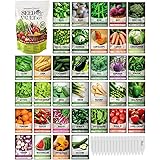DIIYIV Galvanized Raised Garden Bed with Legs,2PCS 48×18×30in Elevated Planter Box for Backyard,Outdoor Garden, Patio, Balcony, 300lb Capacity,Sliver
18% OffLand Guard Galvanized Raised Garden Bed Kit, Galvanized Planter Garden Boxes Outdoor, Oval Large Metal for Vegetables…………
24% OffAre you ready to start your own vegetable garden? If yes, then this guide is for you. Vegetable gardening can be a fun and rewarding experience that allows you to grow fresh produce right in your backyard. In this article, we will cover everything you need to know about starting your first vegetable garden. Let’s get started!
Introduction to Vegetable Gardening:
Vegetable gardening is the practice of growing edible plants in your yard or garden. It involves choosing the right plants, preparing the soil, planting seeds, caring for the crops, and harvesting them when they are ripe. With vegetable gardening, you have complete control over what goes into your food, making it healthier and more sustainable than store-bought produce.
Choosing the Right Plants and Seeds:
The first step in starting your own vegetable garden is selecting the right plants and seeds. You should choose varieties that are suitable for your climate and growing season. Some popular vegetables for beginners include tomatoes, lettuce, spinach, radishes, and green beans. When choosing seeds, look for those with high germination rates and good reviews from other gardeners.
Preparing the Soil and Planting the Seeds:
Once you have selected your plants and seeds, it’s time to prepare the soil. Start by removing any debris or weeds from the area where you plan to plant. Then add compost and other organic matter to enrich the soil. The ideal pH level for most vegetables is between 6.0 and 7.5. You may want to test your soil before planting to ensure it meets these requirements.

Next, follow the instructions on the seed packets to determine how deep to plant each type of seed. Cover the seeds lightly with soil and water thoroughly. Be sure not to overwater as this can lead to root rot.
Caring for Your Vegetables:
After planting, you will need to care for your vegetables regularly. This includes watering, fertilizing, and pruning as needed. How often you water depends on factors such as temperature, humidity, and rainfall. A general rule of thumb is to water deeply once per week if there has been no rain. Fertilizer can also help boost growth and yield. Look for products specifically formulated for vegetables.
Harvesting Your Crops:
Finally, after all your hard work, it’s time to reap the benefits of your labor – literally! Harvesting time varies depending on the crop but generally occurs when the fruit or vegetable is mature and ripe. For example, tomatoes are typically picked when they turn red while leafy greens like lettuce can be harvested at any stage.
In conclusion, starting your own vegetable garden can be an exciting and rewarding experience. By following these steps and taking care of your plants, you can enjoy fresh, home-grown produce in no time. Happy gardening!
Related Content
- Weekly composting events in Heights to continue
- Introducing Compo Soil: The World’s First Food Waste Compost… | MENAFN.COM
- Mayor unclear on why council didn’t withdraw support before consent hearing
- Save Money On Fertilizers And Pesticides By Trying These Top Organic Gardening Ideas
- Daybreak Farms aiming to achieve zero-waste, cage-free facility















































